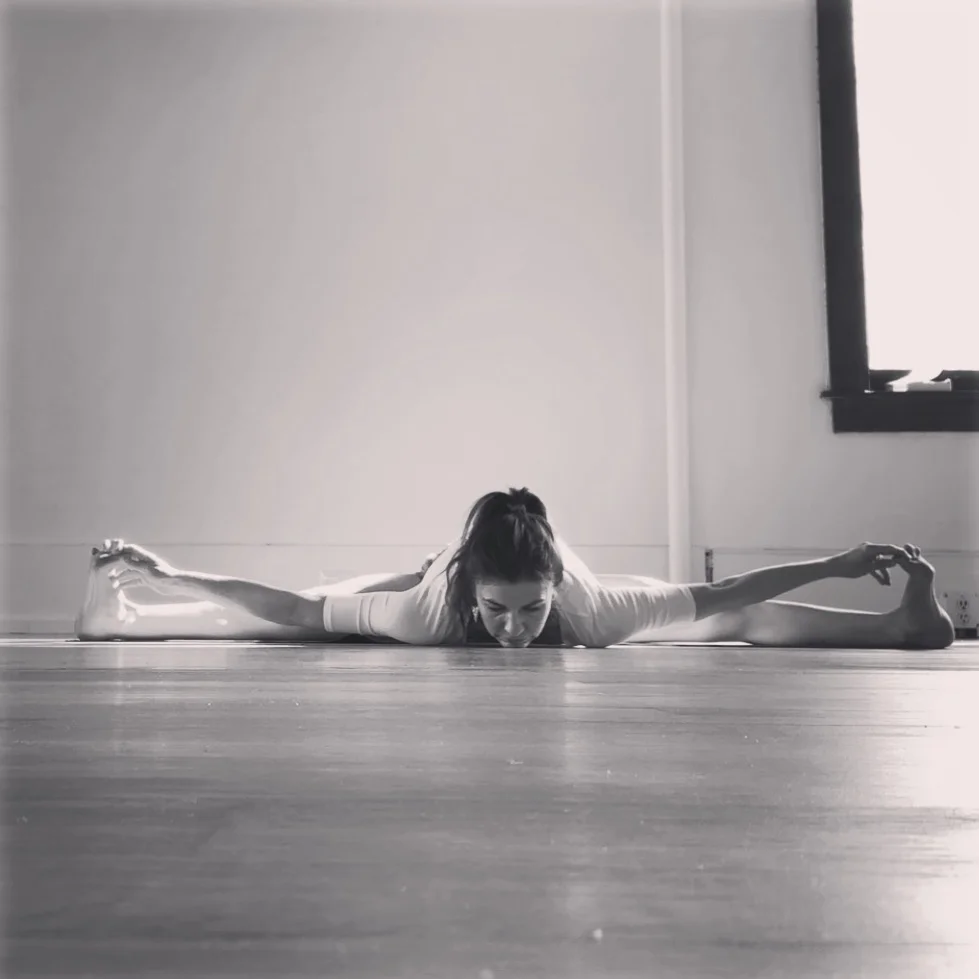“In Yoga the practitioner lives in deep silence and turns inwards to behold and experience the inner hidden light and beauty wherein unalloyed truth and wisdom dwell.” Yogācārya B.K.S. Iyengar, Art of Yoga, 1985, p.20.
MOMENTS
There are moments that cry out to be fulfilled.
Like, telling someone that you love them.
Or, giving your money away, all of it.
Your heart is beating, isn’t it?
You aren’t in chains, are you?
There is nothing more pathetic than caution
when headlong might save a life,
even, possibly, your own. —Mary Oliver
In Yoga the body disciplines the mind and the mind disciplines the body. The mind cannot think of the soul as long as it is connected to the body. The body must be trained to be the servant not the master. —Yogācārya B.K.S. Iyengar
Vrśchikāsana I - scorpion pose
Losing separateness
“I ascend from the moon, I ascend from the night, and perceive of the ghastly glitter the sunbeams reflected
There is that in me... I do not know what it is... but I know it is in me” —-Walt Whitman
“How can you separate me from the universe? We are interwoven with it... I don’t have to seek it because I never left it. The universe is also dependent on me. If the universe is dependent on me, then I have to take care of it. Instead of being separated from God, I have to take care of my part of it...
Look, where do you get involved and not get involved? Both are correct... I’m not asking you to change your behavior, I’m asking you to look at why you do what you do...
What are you responsible for? What are we going to take care of? If you really believe in God, then we see that it’s part of everything, and we have to take a stand against things that are tearing its fabric apart.
My responsibility rises when there is no sense of separation.” Excerpts from Yoga philosophy talk by Manouso Manos, March 6, 2018 Intensive at the Abode of Iyengar Yoga.
Effort and surrender
There is a “difference between doing nothing, doing a little, and the redemptive act of true effort.” Mary Oliver
One of the themes Manouso Manos brought up a couple of times at the Intensive was that we live in a present culture where we are accustomed to everyone receiving awards/rewards whether they have worked or not, for example all participants given a ribbon or trophy despite unequal effort or talent. This is not reality, not how it actually works in the universe. Just barely showing up isn’t going to be enough in many instances to affect a real change, to get to the next level, to understand oneself on a deeper level.
This is similar to the theme that I was teaching or talking about at the weekend Intensive in February, bringing up the essay from The NY Times about living in an age of convenience where we have become accustomed to doing the easiest thing so much that we are losing the ability to make meaningful choices and put forth meaningful effort.
It takes a long time to transform oneself, and it takes true effort in the right direction, persistence, concentration and will-power and sometimes even surrender.
At the Therapeutics training with Manouso, I was fortunate to be assisting and learning while he worked with someone that had a calcified shoulder due to a stroke and not having moved that arm for ten years. This man was willing—asking for help. Manouso gently moved his arm, carefully keeping the shoulder in the joint, gradually extending the range of motion. There was a transformation of reaction from contorted face, gritted teeth (because it is painful to regain mobility when there is calcification), some soft swearing. Manouso cracked jokes. Gradually the tension changed from swearing to calling out for the Lord and then I knew he would be ok. Manouso advised him to use his exhalations. The man softened further. With help, he regained the freedom to move his arm. Now it has to be retrained to connect to his brain. And that possibility now exists. While this is an intense example, this is actually the type of difficulty that we may face in our practice. It takes courage and persistence to move past obstacles and to find freedom.
Thousands of voices
“God’s silence never breaks, but is that really a problem? After all there are thousands of voices, after all.” Mary Oliver
“Selfless love is founded in the perception of unity, not difference. The strength of a mother’s love derives from her unity with her child. In unity there is no possession, as possession is a dual state, containing me and it. Soul is unchanging, eternal, and constant; it always remains as witness, rooted in divine origin and oneness.” Yogācārya B.K.S. Iyengar, Light on Life, 2005, p.9.
This evening my children suddenly joined me in practicing Adho Mukha Vrksāsana. No invitation needed, no teaching, no hesitation, no fear — joyful in success and tumbles alike. “Be fearless” Manouso Manos
Moving forward
There is a “difference between doing nothing, doing a little, and the redemptive act of true effort.” Mary Oliver
One of the themes Manouso Manos brought up a couple of times at the Intensive was that we live in a present culture where we are accustomed to everyone receiving awards/rewards whether they have worked or not, for example all participants given a ribbon or trophy despite unequal effort or talent. This is not reality, not how it actually works in the universe. Just barely showing up isn’t going to be enough in many instances to affect a real change, to get to the next level, to understand oneself on a deeper level.
This is similar to the theme that I was teaching or talking about at the weekend Intensive in February, bringing up the essay from The NY Times about living in an age of convenience where we have become accustomed to doing the easiest thing so much that we are losing the ability to make meaningful choices and put forth meaningful effort.
It takes a long time to transform oneself, and it takes true effort in the right direction, persistence, concentration and will-power and sometimes even surrender.
At the Therapeutics training with Manouso, I was fortunate to be assisting and learning while he worked with someone that had a calcified shoulder due to a stroke and not having moved that arm for ten years. This man was willing—asking for help. Manouso gently moved his arm, carefully keeping the shoulder in the joint, gradually extending the range of motion. There was a transformation of reaction from contorted face, gritted teeth (because it is painful to regain mobility when there is calcification), some soft swearing. Manouso cracked jokes. Gradually the tension changed from swearing to calling out for the Lord and then I knew he would be ok. Manouso advised him to use his exhalations. The man softened further. With help, he regained the freedom to move his arm. Now it has to be retrained to connect to his brain. And that possibility now exists. While this is an intense example, this is actually the type of difficulty that we may face in our practice. It takes courage and persistence to move past obstacles and to find freedom.
Perspective & Self-reflection
Yoga Philosophy Talk, Mr. Manouso Manos, Intensive at the Abode of Iyengar Yoga, Day 1:
“What are we doing here? Why do we do what we do? Where are we making our choices and why? Some do things out of guilt—some will try to turn up the shame on us so that we stay in our box. ‘The unexamined life is not worth living.’
Yoga is part of the six great darśanas (called “mirrors of spiritual perception” in Light on Pranayama) of India.
Looking deeply and questioning may provoke a sense of wonder, excitement and restructuring of everything we think we know.
Oldest definition of Yoga may be “Yoga is the chariot that takes you to heaven.” The Bhagavad Gita about 5000 years ago calls Yoga “skillful action”. This is doing the right thing at the right time. Truth is not an absolute...”
Manouso tells some strange stories with strange choices from the Mahabharata which exemplify the point of taking a look at where we draw our lines about morality, how we make our choices... “Truth is a moral dilemma—how do you justify your existence? What is your social contract? Do you try to hold other people to a higher standard than yourself?” He gives some examples: a potential student interested in studying with BKS Iyengar but needed to know whether he ate a vegan diet first—or he wasn’t pure enough for this student. Another example was that at the Republican Convention in Ohio there were no guns allowed in, although the state law permits concealed and carried handguns so those going to a restaurant would be sitting with others who have guns, but the Republican politicians didn’t have to worry about that.
”What stories do you tell you about you? Look at the stories you tell others and look at where you shave the truth... is there a right time to tell the truth? This self-examination is life-changing. When practicing, can you look to see what you do first, second, and third? Look at the interaction between actions. Integrities can be changed to make different effects. What was the truth then, may not necessarily be the truth now. Keep asking, why do you do the things that you do? Because it works better for me? The āsana can make you re-examine what you do... “
this sharing is distorted by my act of listening to his talk 2 weeks ago, periodic note-taking and then rewriting... i take responsibility for any mistake, offense, or confusion. Any light this sharing brings, the credit is due to Manouso...













